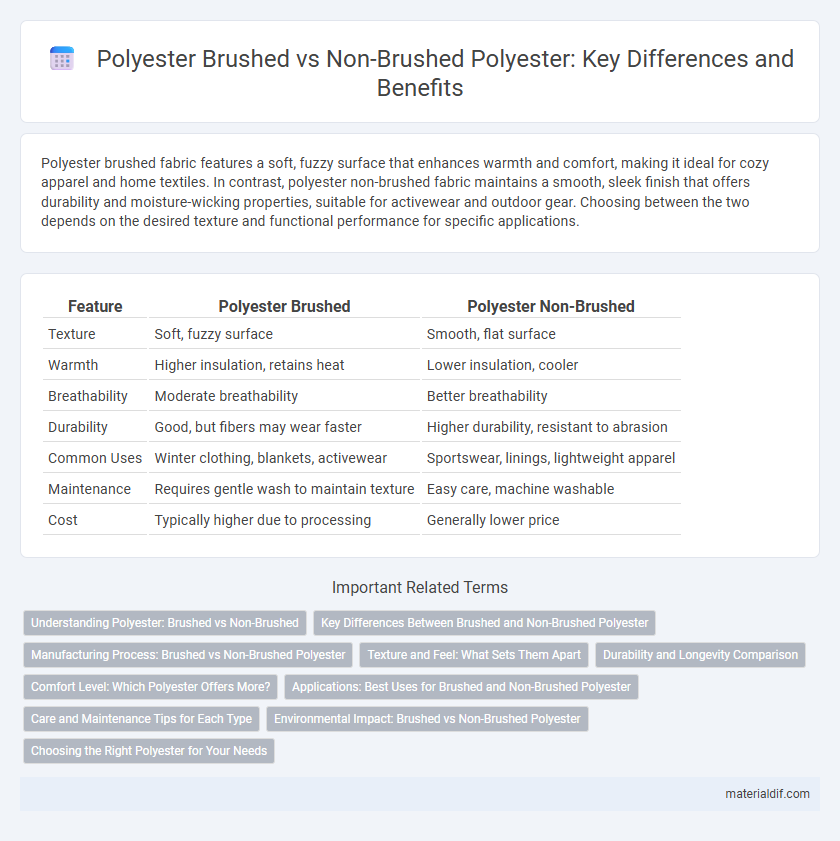Polyester brushed fabric features a soft, fuzzy surface that enhances warmth and comfort, making it ideal for cozy apparel and home textiles. In contrast, polyester non-brushed fabric maintains a smooth, sleek finish that offers durability and moisture-wicking properties, suitable for activewear and outdoor gear. Choosing between the two depends on the desired texture and functional performance for specific applications.
Table of Comparison
| Feature | Polyester Brushed | Polyester Non-Brushed |
|---|---|---|
| Texture | Soft, fuzzy surface | Smooth, flat surface |
| Warmth | Higher insulation, retains heat | Lower insulation, cooler |
| Breathability | Moderate breathability | Better breathability |
| Durability | Good, but fibers may wear faster | Higher durability, resistant to abrasion |
| Common Uses | Winter clothing, blankets, activewear | Sportswear, linings, lightweight apparel |
| Maintenance | Requires gentle wash to maintain texture | Easy care, machine washable |
| Cost | Typically higher due to processing | Generally lower price |
Understanding Polyester: Brushed vs Non-Brushed
Polyester brushed fabric features a soft, fuzzy surface achieved by brushing the fibers, enhancing warmth and comfort, ideal for cold-weather apparel and cozy textiles. Non-brushed polyester retains a smooth, sleek finish with greater durability and moisture-wicking properties, making it suitable for activewear and outdoor gear. Understanding the brushed versus non-brushed polyester differences helps in selecting the right material based on texture, insulation needs, and performance requirements.
Key Differences Between Brushed and Non-Brushed Polyester
Brushed polyester features a soft, fuzzy surface created by a mechanical process that raises the fibers, enhancing warmth and comfort, while non-brushed polyester retains a smooth, sleek finish ideal for moisture-wicking and durability. The brushing process increases fabric thickness and insulation, making brushed polyester suitable for cold-weather apparel, whereas non-brushed polyester excels in lightweight, breathable activewear. These differences affect texture, thermal properties, and application, guiding consumer choice based on desired use and performance.
Manufacturing Process: Brushed vs Non-Brushed Polyester
Brushed polyester undergoes an additional finishing process where the fabric surface is mechanically brushed to raise fine fibers, enhancing softness, warmth, and texture. Non-brushed polyester skips this step, retaining a smoother surface with a tighter weave, resulting in a lighter and more durable fabric ideal for moisture-wicking and outdoor applications. The manufacturing distinction impacts fabric performance, comfort, and end-use suitability in textile production.
Texture and Feel: What Sets Them Apart
Polyester brushed fabric undergoes a mechanical process that raises the fibers, creating a soft, fuzzy texture that enhances warmth and comfort. In contrast, polyester non-brushed retains a smooth, sleek surface that feels lightweight and breathable against the skin. The distinct tactile qualities of brushed polyester make it ideal for cozy apparel, while non-brushed polyester suits activewear and outer layers requiring moisture-wicking properties.
Durability and Longevity Comparison
Polyester brushed fabric features a soft, raised surface that enhances comfort while maintaining high durability, making it resistant to wear and tear over time. In contrast, polyester non-brushed fabric offers a smoother texture with slightly greater strength and abrasion resistance, contributing to superior longevity in high-use applications. Both fabrics excel in durability, but non-brushed polyester generally outperforms brushed polyester in maintaining structural integrity under extended stress.
Comfort Level: Which Polyester Offers More?
Polyester brushed fabric provides superior comfort compared to non-brushed polyester due to its softer, fuzzier surface that enhances warmth and coziness. The brushed texture traps more air, improving insulation and making it ideal for colder climates or cozy apparel. Non-brushed polyester, while durable and smooth, lacks this plush feel, resulting in a less comfortable experience, especially in chilly conditions.
Applications: Best Uses for Brushed and Non-Brushed Polyester
Brushed polyester features a soft, fuzzy surface that enhances insulation and comfort, making it ideal for cold-weather clothing, blankets, and upholstery. Non-brushed polyester offers a smooth texture with moisture-wicking properties, commonly used in activewear, outdoor gear, and home textiles where durability and breathability are essential. Selecting between brushed and non-brushed polyester depends on the need for warmth and softness versus lightweight, moisture management, and ease of maintenance.
Care and Maintenance Tips for Each Type
Polyester brushed fabrics require gentle washing with mild detergents and low heat drying to maintain their softness and prevent pilling, while avoiding fabric softeners that can damage the brushed surface. Non-brushed polyester is more durable, allowing for regular machine washing and higher heat drying without compromising the fabric's strength or color retention. Both types benefit from air drying when possible and ironing on low heat to avoid melting or distortion of synthetic fibers.
Environmental Impact: Brushed vs Non-Brushed Polyester
Brushed polyester undergoes an extra mechanical process that slightly increases its energy consumption and water usage compared to non-brushed polyester. This additional brushing step can lead to a marginal rise in carbon emissions and wastewater production, impacting the overall environmental footprint. However, non-brushed polyester typically requires fewer resources during manufacturing, making it a more sustainable option in terms of energy efficiency and water conservation.
Choosing the Right Polyester for Your Needs
Polyester brushed fabric offers a soft, fuzzy surface ideal for warmth and comfort, making it perfect for cozy clothing and blankets. Polyester non-brushed retains a smooth, durable texture suited for activewear and outdoor gear due to its moisture-wicking and quick-dry properties. Selecting the appropriate polyester depends on the intended use, balancing comfort with performance requirements.
Polyester Brushed vs Polyester Non-Brushed Infographic

 materialdif.com
materialdif.com